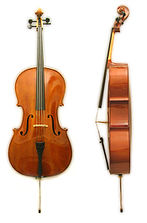
Back عائلة الكمان Arabic Viiuli perekond Estonian خانواده ویولن Persian Keluarga biola ID Fiðlufjölskyldan Icelandic Famiglia del violino Italian ヴァイオリン属 Japanese 바이올린족 Korean Família dos violinos Portuguese Fiolfamiljen Swedish
This article includes a list of general references, but it lacks sufficient corresponding inline citations. (February 2016) |
 |
| Part of a series on |
| Violin |
|---|
| Violinists |
| Fiddle |
| Fiddlers |
| History |
| Musical styles |
| Technique |
| Acoustics |
| Construction |
| Luthiers |
| Family |
The violin family of musical instruments was developed in Italy in the 16th century.[1] At the time the name of this family of instruments was viole da braccio which was used to distinguish them from the viol family (viole da gamba).[2] The standard modern violin family consists of the violin, viola, cello, and (possibly) double bass.[3][4][5]
Instrument names in the violin family are all derived from the root viola, which is a derivative of the Medieval Latin word vitula (meaning "stringed instrument").[6] A violin is a "little viola", a violone is a "big viola" or a bass violin, and a violoncello (often abbreviated cello) is a "small violone" (or literally, a "small big viola"). (The violone is not part of the modern violin family; its place is taken by the modern double bass, an instrument with a mix of violin and viol characteristics.)

|

|

|

|
| Violin | Viola | Cello | Double bass |
|---|
- ^ Witten 1982
- ^ Viola da braccio literally means "viol [played or held] on the arm". Not all members of the family were or are held against the chest or between chin and shoulder, but that some were was enough to distinguish them from the violas da gamba, literally "viol [played or held] on the leg", which, except for the biggest ones, were held between the knees or resting in the lap, and, most significantly, none of which were played a braccio
- ^ Hoffman 1997
- ^ Some sources do not include the double-bass in the violin family
- ^ Until the end of the 17th century the violin family also included the tenor violin tuned a fifth above the cello; until the 18th century there was also the violino piccolo tuned one fourth above the violin; besides the Syntagma Musicum of Michael Praetorius shows two types of three string treble violins tuned one octave above the violin called in that work "kleine Poschen" and which seem to be very similar to the later Kit violins or pochettes: see Syntagma Musicum, vol. 2, page XXI
- ^ Harper 2001.
© MMXXIII Rich X Search. We shall prevail. All rights reserved. Rich X Search